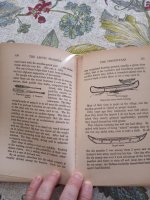Whitewater canoes or boats with a blunt "bottle nose" water entry tend to behave differently than boats with a sharp prow water entry. Modern solo whitewater canoeing technique has evolved to what is often called a "cab forward" technique using strokes (forward and cross forward) in the bow on-side and off-side quadrants as exclusively as possible. This technique requires paddling in arcs of various radii utilizing hull carving to be efficient.
In whitewater boats are most often heeled toward the paddling side, although there are exceptions. A lot of whitewater hulls, both kayak and canoe, have evolved toward rather flat hull bottoms with sharper chines. Those sharper chines can be used to facilitate hull carving and also for maintaining directional stability for ferries in strong current. Paddling in arcs works very well for whitewater paddling since you want to follow a curved path at least as often, if not more often than a straight path.
Lets say you want to paddle an inside circle on your on-side. If your strong paddling side is on the right side of the canoe you first develop some forward momentum which can be done using some combination of forward and cross-forward strokes. You then initiate a carve toward your onside with some sort of stroke. This could be a strong cross-forward, a C stroke, or a stern pry, or a strong J stroke. Simultaneously, you heel the boat toward your on-side. Because you have forward momentum an asymmetrical bow wave builds up that puts greater frontal resistance on the outside of the arc, in this case the port bow. That tends to resist the tendency of the canoe from turning toward your off-side as you take forward strokes on the inside of the circle.
Once you have the boat carving a circle (actually an arc) you can adjust the radius of that circle, either tightening the turn or straightening it by adjusting four different elements of your paddling technique. These include stroke cadence, stroke position (forward and aft) and stroke excursion, paddle shaft angle more or less vertical (with the paddle blade closer or a bit farther from the boat), and the degree of heel. Each of these elements can be adjusted individually or simultaneously.
Of course, it is also possible to carve circles on the off-side using cross forward strokes.
Andrew Westwood, who loves acronyms, has called this the "2x4" technique". Following is a short description of this technique. I object rather strenuously to the notion that Andrew "developed" this technique since Charlie Wilson described the same thing many years earlier and Tom Foster based his entire whitewater OC-1 and C-1 instructional curriculum on it.

westwoodoutdoors.ca

